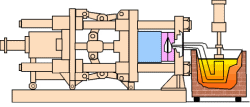Zinc Die Casting Company Die Casting Process. Zinc Die casting is a process that requires great pressure to force the metal to melt and mold it into different shapes. It is best for applications that require a large quantity of small- or medium-sized parts that require good detailing, with fine surface quality, and with a dimensional consistency.
Die casting process is done using non-ferrous metals like zinc, copper, aluminum, magnesium and others. Zinc die casting process is among the most famous castings done in an alloy. The process involves four steps: spraying, filling, opening, and scraping.
The first step is done by spraying a lubricant onto the mold. Lubricant controls the temperature of the die and assists in removing the cast. Second step in zinc die casting process includes filling of die into the molten metal under high pressure. The die is then opened once it solidifies, and the ejector pins eject the shot. Scraping takes place next, wherein the scrap, including the runners, gate, spues, and flash are removed from the casting. Scraping in zinc die casting process is done with the use of a special trim die in a hydraulic press or power press. The conventional method is by sawing or by the use of the hand in which grinding is necessary to remove the scrap marks.
Another way is to tumble shot if the gates are easily broken and thin. Gates and the finished parts should be separated. The scraps are recycled by melting them again and molding them into different shapes and sizes.


